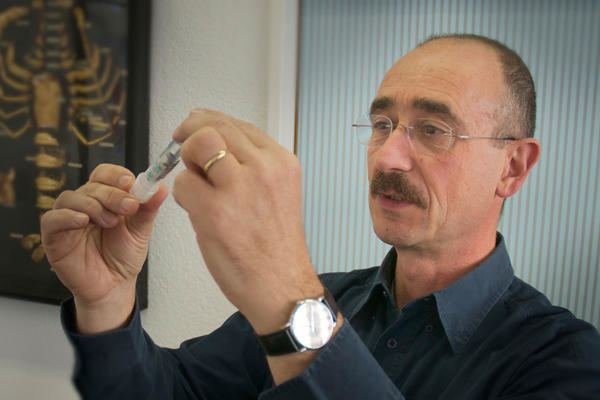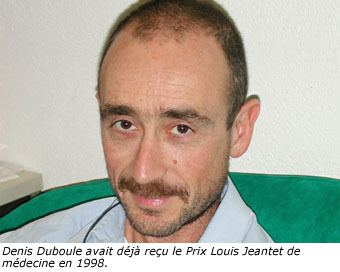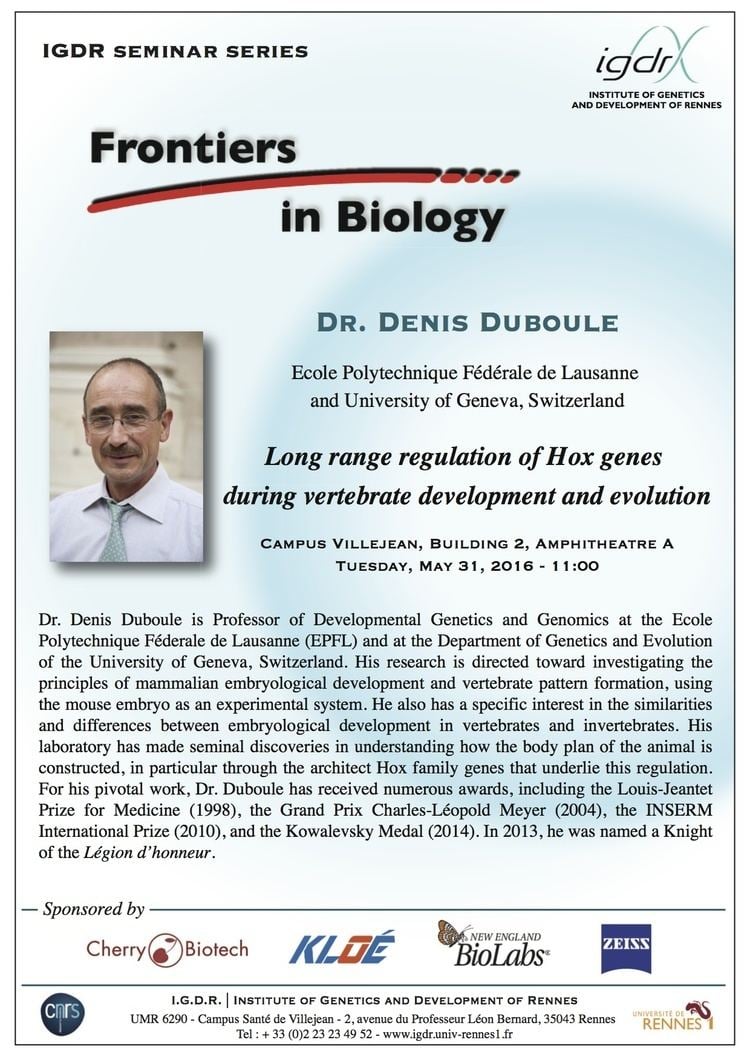Citizenship Swiss and French Fields Developmental biology | Name Denis Duboule Role Biologist | |
 | ||
Notable awards Louis-Jeantet Prize for Medicine (1998)Marcel Benoist Prize (2003)Grand Prix Charles-Leopold Mayer (2004)Fellow of the Royal Society and foreign membership to the National Academy of Sciences USA (2012) | ||
L invite de la redaction denis duboule professeur de genetique a l unige et a l epfl
Denis Duboule (born 1955 in Geneva) is a Swiss-French biologist. He earned his PhD in Biology in 1984 and is currently Professor of Developmental Genetics and Genomics at the École polytechnique fédérale de Lausanne (EPFL) and at the Department of Genetics and Evolution of the University of Geneva. Since 2001, he is also the Director of the Swiss National Research Center "Frontiers in Genetics". He has notably worked on Hox genes, a group of genes involved in the formation of the body plan and of the limbs.
Contents
- L invite de la redaction denis duboule professeur de genetique a l unige et a l epfl
- Denis duboule prix international inserm 2010
- Biography
- Scientific contributions
- Fellowships
- Editorial boards
- Honours
- Publications
- References

Denis duboule prix international inserm 2010
Biography
Denis Duboule obtained a PhD from the University of Geneva in 1984. After questioning Karl Illmensee's claims of having cloned a mouse, Duboule departed to work as a post-doc and then a group leader at the University of Strasbourg, with Pierre Chambon. In 1988, he became a group leader at the European Molecular Biology Laboratory in Heidelberg, Germany.

In 1992, he obtained a tenure at the Geneva University. From 1997, he has headed the Department of Genetics and Evolution (formerly Zoology and Animal Biology) Since 2001, he has also chaired the NCCR Frontiers in Genetics and, since 2006, he is a full professor at the École polytechnique fédérale de Lausanne (EPFL).
He is a Fellow of the Royal Society. and a foreign membership to the National Academy of Sciences, USA (2012). He is also an occasional columnist in the "Sciences and environment" section of the newspaper Le Temps.
Scientific contributions

Denis Duboule's contributions are in the field of vertebrate developmental genetics with an interface with medical genetics, evolutionary biology and transcription regulation. Since 1985, he reported several discoveries related to the development and evolution of the mammalian body, in particular concerning the Hox (architect) gene family. In 1986, cloning and structure of the first large complex of Hox genes in the mouse and, in collaboration with S. Gaunt, expression of a Hox gene within neuromeres in the hindbrain, suggesting an analogy with the expression of related genes in Drosophila. In 1988, with S. Gaunt, report of collinear expression of Hox genes in a vertebrate system, thus extending the existence of this phenomenon from Drosophila to vertebrates and other deuterostomes. In 1989, description of 'temporal colinearity' (the Hox clock) an extension of the same principle of colinearity to the timing in the transcriptional activation of these genes. In 1989, with Krumlauf's laboratory, discovery of the structural conservation of the entire homeotic systems between mouse and flies; a single homeotic complex existed in the ancestral animal at the basis of the protostome/deuterostome lineages. In 1989 and 1991, first reports that the same genetic system had been co-opted to take part to the organization of structures along different axial structures, in particular the limbs and the genito-urinary tract. The extension of this work to birds, in collaboration with Cheryll Tickle and Lewis Wolpert demonstrated both the high degree of interspecies conservation and the crucial function of these genes during limb development. In 1991, concept of ‘posterior prevalence’, which accounts for the functional organization of Hox genes. In 1993, genetic demonstration that Hox genes are involved in multiple axial structures via a mutation in a single Hox gene resulting in severe alterations in both the limbs, the axial skeleton and the external genitalia.

In 1994, proposal of the "Developmental hourglass" (egg-timer) concept, claiming for a restriction of phenotypic landscapes during one particular stage in vertebrate development, due to the occurrence of maximal mechanistic constraints. Proposal that Hox genes act as a ‘clock’ and hence that all animals developing their body axis in a time sequence must have at least one full Hox cluster to integrate the time parameter. In 1995, description of Hox genes in the zebrafish and their expression during fin development, leading to a potential scheme for the evolutionary transition from the fin to the limb, where digits are considered as novelties, which appeared together with the emergence of tetrapods. In 1996, link between the dominant negative function of Hox genes and a human genetic syndrome (the type II syndactyly or synpolydactyly) via posterior prevalence.

From 1997 to 2001, Duboule's laboratory has approached the problem of collinearity at the mechanistic level by using ES cell-based genetics; Hox genes are controlled at a global level, which involves their respective positions in the gene cluster. In 2001, a link is established between temporal colinearity (the Hox clock) and the somitic clock, such as to coordinate the progression of somites and their specifications. From 1998 onwards, this laboratory has used two home-designed genetic approaches TAMERE and STRING to embark on an in vivo analysis of large-scale gene regulation, leading to the concepts of ‘regulatory landscapes’ or archipelagos. This large allelic series has allowed to recently unravel the mechanisms underlying colinearity in the developing limbs. The axial organization of our legs and arms indeed matches the linear organization of regulatory chromatin domains. The transition between these chromosomal domains matches the wrist, i.e. the transition between the old (arms and legs) and the "novel" (hands and feet) part of our appendages. Duboule has also studied in details the biochemical mechanisms underlying Hox gene regulation the processing of the Hox clock during the formation of the main body axis. This clock is linked to a transition in chromatin domains, which is accompanied by a step-wise switch of genes from a negative to a positive chromatin compartment.
The potential importance and meaning of these observations for our understanding of gene regulation during development and morphological evolution have been discussed in several reviews.
Fellowships
Editorial boards
Honours
Publications
Articles
NCBI publication list D. Duboule
Books
Duboule, D. (ed) (1994) A guidebook to homeobox genes. Oxford University Press
Hafen, E., Bopp, D., and Duboule, D. (Eds) (2002) Developmental Biology in Switzerland, Int. J. Dev. Biol., Volume 46.
